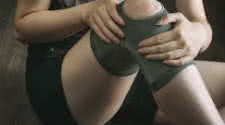Exercising with Bad Knees - Arthritis Pains of the Knee

Always Avoid Exercises that Cause Pain
Anyone who exercises or works strenuously where the activity includes repetitive knee-bending under stress is at risk for eventually developing degenerative arthritis of the knees. This
includes bodybuilders, weightlifters (squats, supine leg-pressing, competitive lift-training such as clean and jerks and snatches), runners, tennis players and any athlete who runs a lot,
as in football, rugby and soccer.
As we grow older, and related to the degree of wear and tear our knees have been exposed to over the years, age alone can lead to the development of progressive degenerative arthritis
of the knee joints. Degenerative arthritis is the medical name given to joints that have been worn out by long-term usage under physical stress. The cartilaginous surfaces of the ends
of the bones become thin and bare spots occur where bone grates upon bone, producing severe pain and limitation of function.
At the present time there is no way to avoid this problem other than to abstain from those activities that make it worse. However, there may be some hope for retarding the process by
medication. A recent small study (212 people) in Europe showed that over a two-year period the range of motion was better and pain was less in those 106 people who took 1500 mg of
chondroitin sulfate a day compared to the 106 who took a sugar pill. This study is flawed by its lack of statistical validity but, hopefully, further more extensive testing will prove it
to be of value.
If the symptoms become severe enough, surgical replacement of the ends of the bones with metal and the insertion of a plastic filler between them can permit the resumption of painless
walking. In my own case, after 20 years and 15,000 miles of jogging, I developed severe degenerative arthritis in both knees. Five unsuccessful knee arthroscopies later I finally had
both knees surgically replaced, so I can speak with considerable authority about bad knees.
The primary problem of exercising with bad knees is weight-bearing, particularly weight-bearing while bending the knees, as in walking, running, squatting, stair-climbing, or riding an
ordinary upright bicycle. The object of exercising with bad knees is to avoid bent-knee weight-bearing. Merely standing or weight-bearing without bending the knees is usually fairly well
tolerated, as is exercising while sitting or lying down.
The range of motion of the knees is often compromised in degenerative arthritis. One must try to maintain as much range of motion as possible. Lack of exercise and normal use of the
knees can result in joint adhesions and even lead to frozen joints. Simple range-of-motion exercises done lying down or on a recumbent bike can help maintain what range of motion you
have and, over time, can extend the range considerably. You should do the exercises with no weight-bearing pressure on the knees. Simple flexion and extension while supine or gentle
careful movements on a recumbent bike are good examples. Both have the capacity of increasing the workload in mild degrees to extend the range of motion, lying supine with ankle weights,
and on the bike with gradual increases in resistance.
Upper-body exercises are no problem. All you need is a bench and a pair of interchangeable-weight dumbbells. Sitting on the end of the bench you can do concentration curls, shrugs, forward
and lateral raises and the military press. Lying down you can do fives and bent-arm presses. If you have access to a health club, you can add supine bench pressing and on a high pulley
various pulldowns and pushdowns. Just make sure to keep your knees locked and straight. On the low pulley you can do seated rowing as long as the knees are locked. Try using both wide and
narrow grips.
As in all weight exercises, start with light weights that you can handle easily for 12 to 15 repetitions. Then gradually increase the weights as you decrease the repetitions.
The legs present a bigger and more difficult problem. Leg extensions, squats, treadmills, aerobics, stair-climbers, jogging and upright bike-riding are out. You can pedal a recumbent bike -
on which your legs are at almost full extension - with very little, if any, discomfort. This exercise doesn't develop much strength or muscular bulk, but it is very good for cardiovascular
fitness and muscle tone of the thigh muscles. Bend your knees no more than necessary. Without any weight on the knees they are usually free of significant pain. Starting slowly and
gradually increasing the speed serves as a cardiovascular warmup.
Exercising the thigh muscles is challenging, but thigh machines are available that permit motion against resistance in four directions without any pressure on the knees at all. This method
applies pressure against the thigh just above the knee by means of a foam pad. I recommend this type of machine for anyone who has had knee-replacement surgery, which always results in
thigh-muscle atrophy. It can restore some of the thigh musculature.
If you keep your knees straight and locked, you can do toe raises for your calves, but use only your bodyweight. For back exercise sit on the end of the bench and bend forward, up, and side
to side, holding a dumbbell in each hand.
Those who have not done any particular exercise before should use a light weight and do only a few reps. If you are sore the next day, rest a day before you go back to that exercise. As a
general rule, restricting your total reps to a maximum of 30 to 35 will prevent next-day soreness once you are in reasonably good physical condition.
There is no reason you can't continue exercising regularly despite having bad knees. Just remember you must avoid unnecessary pres-sure on your knees by following the foregoing advice. If
you stay with your program, you can keep muscle tone and cardiovascular fitness.